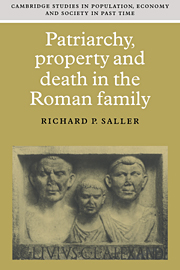Book contents
- Frontmatter
- Contents
- List of tables
- Preface
- Abbreviations
- 1 Introduction: approaches to the history of the Roman family
- Part I Roman life course and kinship: biology and culture
- Part II Roman family and culture: definitions and norms
- Part III The devolution of property in the Roman family
- 7 Strategies of succession in Roman families
- 8 Guardianship of Roman children
- 9 Dowries and daughters in Rome
- 10 Conclusion
- Bibliography
- Index
- Cambridge Studies in Population, Economy and Society in Past Time
7 - Strategies of succession in Roman families
Published online by Cambridge University Press: 23 November 2009
- Frontmatter
- Contents
- List of tables
- Preface
- Abbreviations
- 1 Introduction: approaches to the history of the Roman family
- Part I Roman life course and kinship: biology and culture
- Part II Roman family and culture: definitions and norms
- Part III The devolution of property in the Roman family
- 7 Strategies of succession in Roman families
- 8 Guardianship of Roman children
- 9 Dowries and daughters in Rome
- 10 Conclusion
- Bibliography
- Index
- Cambridge Studies in Population, Economy and Society in Past Time
Summary
After young Calpurnia's miscarriage, Pliny wrote as a concerned husband to her grandfather, Calpurnius Fabatus, to soothe his disappointment at being deprived of posteri (descendants) late in life: “You do not desire greatgrandchildren more passionately than I desire children, to whom I expect to leave, from my side of the family and from yours, an easy path to honors with names widely known and ancestral masks of respectable age” (Ep. 8.10.3). Fronto two generations later expressed a similar hope for posterity from the marriage of his daughter. The concern for posterity and the reference to imagines (death masks) may summon up notions of lines of descent through the generations. The difficulties of successfully planning male lines of descent have been elucidated: in order to have male descendants with property to maintain their status, families had to try to strike a delicate balance between bearing too many children and bearing too few.1 A Roman father producing many was more likely to have male heirs to succeed him, but also to have to divide his property in a partible system among so many heirs that each would be left with too little to maintain the family's status; a father producing two or three children lessened the risk of fragmentation of his estate, but also was unlikely to have a son to succeed him. The unpredictability of high mortality often spoiled the most careful strategy to leave one and only one male heir to perpetuate the family name with its splendid patrimony intact.
- Type
- Chapter
- Information
- Patriarchy, Property and Death in the Roman Family , pp. 161 - 180Publisher: Cambridge University PressPrint publication year: 1994



